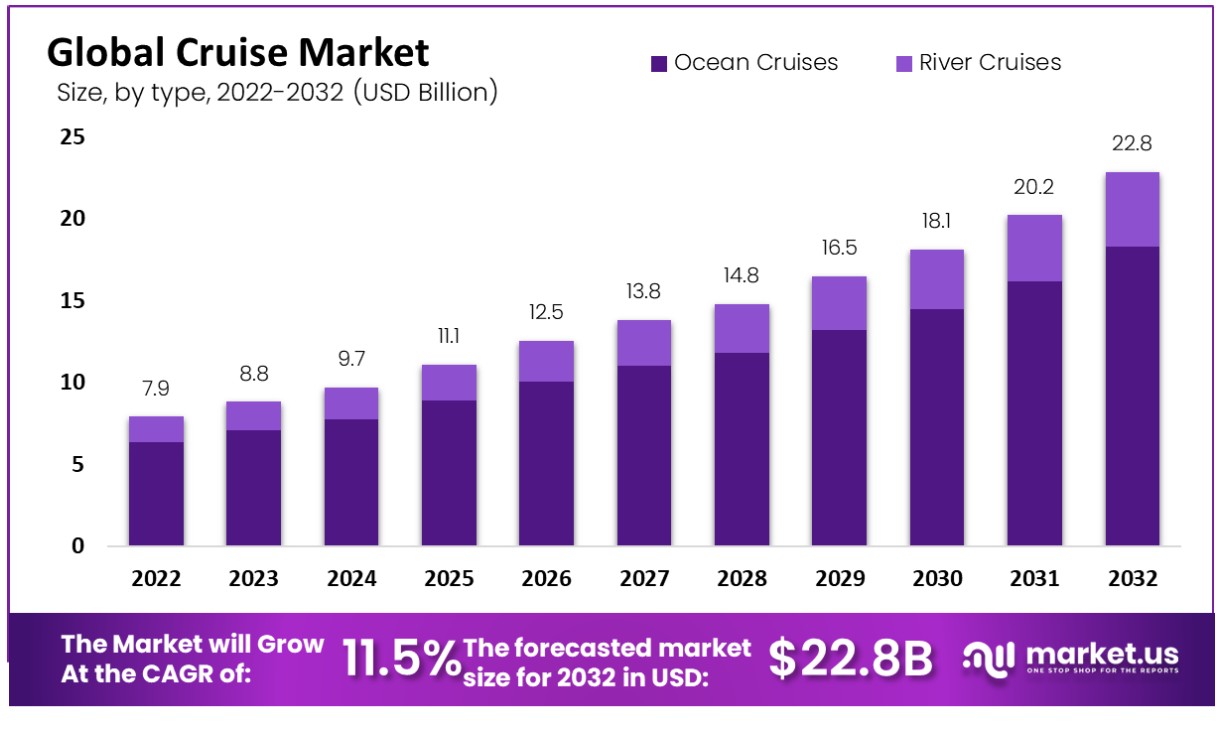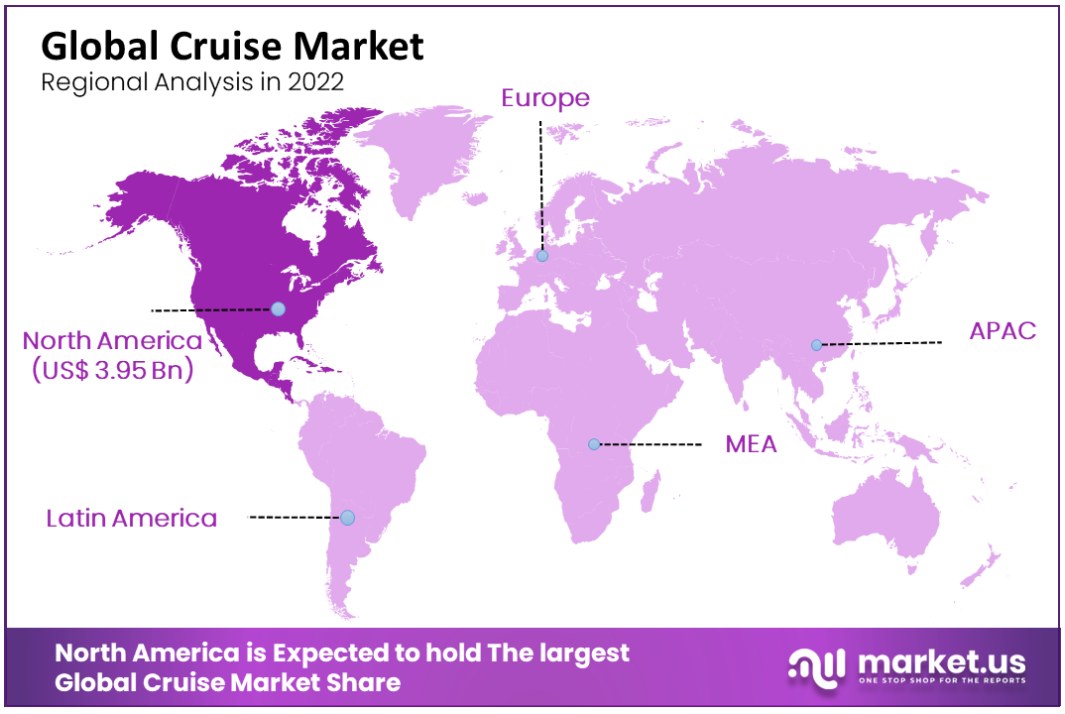Global Cruise Market, By Type (Ocean Cruises and River Cruises), By Region and Companies - Industry Segment Outlook, Market Assessment, Competition Scenario, Trends, and Forecast 2023-2032
- Published date: May 2023
- Report ID: 22103
- Number of Pages: 242
- Format:
- keyboard_arrow_up
Quick Navigation
Report Overview
The Global Cruise Market size is expected to be worth around USD 22.8 Billion by 2032 from USD 7.9 Billion in 2022, growing at a CAGR of 11.50% during the forecast period from 2023 to 2032.
A cruise is a multi-day vacation plan that is arranged on a cruise ship large inland while visiting numerous tourist attractions along a planned route. On this kind of trip, the focus is mostly on the ship’s accommodations as well as tourist-attractive locations. The global cruise market is being driven by the expanding hospitality and tourist industries.
Ships are introducing new technologies, a variety of exciting activities, as well as enjoyable themes for travelers, including yoga themes, kid themes, mystery themes, and others. Such innovations are attracting different populations and acquiring massive popularity among the target audience, which is driving the cruise business. The market is expected to increase as a result of the new generation’s increasing preference for leisure travel and adventures with the rising number of people who want to live a luxurious life.

Driving Factors
Consumer Demand:
Cruise lines have seen an exponential rise in demand over recent years as more travelers search for unique travel experiences. This has led to growth within the industry, as cruise lines expand their fleets and add new routes to keep up with demand.
Innovation:
Cruise lines are constantly innovating and introducing new features and amenities to attract customers. This includes everything from entertainment options to advanced technology and unique dining experiences.
Expansion of Cruise Line Offerings:
Cruise lines are expanding their services to include niche markets like adventure cruises, river cruises, and small-ship cruising to appeal to different types of travelers.
Restraining Factors
Natural disasters like hurricanes and earthquakes can disrupt cruise itineraries and impact passenger safety. Geopolitical impacts such as terrorism or political instability also impact cruise demand and itinerary planning. Building and maintaining a cruise ship requires significant capital, which limits market participants, creating limited competition and less price flexibility.
Furthermore, environmental regulations in the industry contribute to higher operational costs which in turn reduce profit margins; cruise lines must invest in cleaner technologies to reduce their environmental footprint, adding to their expenses. Outbreaks of contagious illnesses like COVID-19 can damage the reputation of the cruise industry and sap consumer confidence in sailing.
This could result in decreased demand and revenue for cruise lines. Cruising is typically seasonal, with most travelers opting for cruises during summer holidays. Lower occupancy rates and revenue during off-peak periods impact profitability for cruise companies. Negative media coverage such as reports of passenger injuries or crimes further weakens consumer trust in cruising leading to decreased bookings overall.
Growth Opportunities
Expansion in Emerging Markets
The worldwide cruise market offers several prospects for growth and development, including emerging markets, sustainable tourism, technical improvements, specialized cruises, upselling opportunities, and partnerships and collaborations. Emerging markets such as Asia and South America present major growth prospects for the cruise industry.
These regions boost a growing travel demand, creating an expansive customer base for cruise lines. Furthermore, with growing awareness about the environmental effects of tourism comes an increased interest in sustainable tourism practices; cruise lines that implement sustainable practices and offer eco-friendly itineraries can attract eco-conscious tourists.
Furthermore, advances in technology such as artificial intelligence, virtual reality, and the Internet of Things have the potential to enhance passenger experiences on board while improving operational efficiencies for cruise lines. Specialist cruises, such as wellness cruises, adventure cruises, and culinary cruises can appeal to niche markets and give cruise lines a chance to stand out from competitors.
Cruise lines can generate additional revenue by offering onboard amenities and services like spa treatments, shore excursions, and specialty dining options. Collaborations and partnerships with other travel companies, such as airlines and hotels, can enable cruise lines to extend their reach and offer customers more comprehensive travel experiences.
Latest Trends
The global cruise market is expanding in support of luxury experiences, multigenerational travel, wellness and health, sustainability, and the digital revolution. Cruise lines that can anticipate these developments and respond appropriately will likely be successful in the highly competitive cruise market. River cruising has become increasingly popular in recent years, particularly in Europe and Asia.
River cruises offer a more intimate setting with smaller ships and the chance to visit remote destinations. Sustainability has become a top priority for the cruise industry, with many lines adopting eco-friendly practices such as using clean energy sources, reducing single-use plastics, and encouraging responsible tourism.
Cruise lines are investing in technology to enhance their passengers’ experiences, from mobile apps and wearable devices to virtual reality headsets and AI-powered assistants. Wellness and health have become a major priority for the cruise industry, with many lines offering onboard fitness facilities, healthy dining options, and wellness-themed activities.
Cruise lines are catering to this trend by offering family-friendly amenities like onboard water parks and kids’ clubs. Luxurious and experiential cruises have seen a resurgence in the cruise market, with travelers demanding amenities such as private balconies, and exclusive dining venues. Many are seeking authentic cultural encounters; cruise lines have responded by providing shore excursions that showcase local customs, traditions, and cuisine.
By Type Analysis
The ocean cruises Segment Accounted for the Largest Revenue Share in the Cruise Market
Based on type, the cruise market is segmented into ocean cruises and river cruises. Among these types, the Oceans Cruises segment is the most lucrative in the global cruise market, with a projected total revenue of 80%. The larger market revenue share is attributed to strong players who provide services in the ocean cruises category for transcontinental travel in large numbers. Also, a sizable portion of customers favor ocean cruises over other types of cruises because of the interesting packages, amenities, and entertainment options.
These activities are possible aboard large ocean cruise ships, which offer more room than the others. The global river cruise market is expected to have the fastest growth rate, rising at a CAGR of 13.3%. This growing popularity among vacationers can be attributed to river cruising’s larger size compared to ocean cruises which usually dock along coastal regions. Rivers offer more internal destinations for sightseeing, especially in Europe where some cruise lines offer tours through multiple countries. For instance, Danube River cruises traverse 10 nations within Europe.

Key Market Segments:
Based on Type
- Ocean Cruises
- River Cruises
Based on Applications
- Daily Commute
- Touring
COVID-19 Impact Analysis
The COVID-19 pandemic has had a significant impact on the global cruise market, leading to reduced demand, refunds, operational challenges, decreased revenue, shifts in consumer behavior, and regulatory adjustments. The industry will need to navigate these challenges to recover and rebuild passenger confidence in cruising.
Due to the pandemic, cruise lines have seen a reduction in demand for their services, with many potential passengers opting to postpone or cancel their travel plans due to safety fears. Due to travel restrictions and safety worries, many sailings have had to be canceled. Because of these events, significant financial losses have occurred and customers are now demanding refunds.
The pandemic has also presented cruise lines with several operational difficulties, such as implementing new health and safety protocols and managing crew members who have tested positive for COVID-19. The suspension of operations and decreased demand for cruise lines have resulted in significant revenue losses, which may impact their long-term financial viability.
Furthermore, the pandemic has caused changes in consumer behavior such as an increased focus on health and safety that may influence which types of cruises passengers seek and which amenities are offered. The pandemic has led to increased regulatory scrutiny of the cruise industry, with many countries enforcing new health and safety rules that may impact cost and feasibility when operating cruises.
Regional Analysis
North America Accounted for the Largest Revenue Share in Cruise Market in 2022.
North America dominated the cruise market with the largest revenue share of 50%. Due mainly to its strong presence of international key players and highly developed industry. Higher disposable income levels, consumer spending patterns, and an expanding tourism industry all played their respective roles in driving up market revenue share significantly. The Asia Pacific region is forecast to experience the highest growth rate over the forecast period, with a CAGR of 12.1%.
Recently, cruise industry activity has shifted away from North America and Europe towards Asia Pacific due to government initiatives to develop tourism and increase economic output. For instance, on August 19th, 2020 the Indian government announced the reduction of 70% of berth charges to promote cruise tourism.
Europe ranked second in terms of revenue share in 2021 with over 25% share, expected to achieve an impressive CAGR during the forecast period. The growth is attributed to an uptick in demand for sustainable tourism which in turn makes local communities more appealing to small and medium-sized tour operators, propelling market expansion even further.

Key Regions and Countries
- North America
- The US
- Canada
- Mexico
- Western Europe
- Germany
- France
- The UK
- Spain
- Italy
- Portugal
- Ireland
- Austria
- Switzerland
- Benelux
- Nordic
- Rest of Western Europe
- Eastern Europe
- Russia
- Poland
- The Czech Republic
- Greece
- Rest of Eastern Europe
- APAC
- China
- Japan
- South Korea
- India
- Australia & New Zealand
- Indonesia
- Malaysia
- Philippines
- Singapore
- Thailand
- Vietnam
- Rest of APAC
- Latin America
- Brazil
- Colombia
- Chile
- Argentina
- Costa Rica
- Rest of Latin America
- Middle East & Africa
- Algeria
- Egypt
- Israel
- Kuwait
- Nigeria
- Saudi Arabia
- South Africa
- Turkey
- United Arab Emirates
- Rest of MEA
The global market is dominated by a few major players and numerous small local players. The majority of the market share is held by Carnival Corporation & Plc. and Royal Caribbean Group. Key companies are taking new initiatives to expand their clientele.
Examples include multigenerational packages targeting family travel, kids theme cruise vacations for children, mystery theme cruise vacations, etc. Key players in the global cruise industry are also constantly looking for opportunities in underdeveloped regions.
Market Key Players:
Listed below are some of the most prominent cruise industry players.
- Carnival Corporation & Plc
- Royal Caribbean Group
- MSC Cruises S.A.
- Norwegian Cruise Line Holdings Ltd.
- Disney Cruise Line
- Genting Hong Kong Limited
- Fred. Olsen Cruise Lines
- Other Market Players
Recent Developments:
- Many cruise lines began operations in 2021 after being suspended due to the COVID-19 pandemic. Some lines, such as Royal Caribbean and Celebrity Cruises, require all passengers to be fully vaccinated.
- Despite the pandemic, several new ships were launched in 2021. Royal Caribbean’s Odyssey of the Seas, Carnival Cruise Line’s Mardi Gras, and MSC Cruises’ Virtuosa.
Report Scope:
Report Features Description Market Value (2022) USD 7.9 Bn Forecast Revenue (2032) USD 22.8 Bn CAGR (2023-2032) 11.5% Base Year for Estimation 2022 Historic Period 2016-2022 Forecast Period 2023-2032 Report Coverage Revenue Forecast, Market Dynamics, COVID-19 Impact, Competitive Landscape, Recent Developments Segments Covered Based on Type (Ocean Cruises and River Cruises) Regional Analysis North America – The US, Canada, & Mexico; Western Europe – Germany, France, The UK, Spain, Italy, Portugal, Ireland, Austria, Switzerland, Benelux, Nordic, & Rest of Western Europe; Eastern Europe – Russia, Poland, The Czech Republic, Greece, & Rest of Eastern Europe; APAC – China, Japan, South Korea, India, Australia & New Zealand, Indonesia, Malaysia, Philippines, Singapore, Thailand, Vietnam, & Rest of APAC; Latin America – Brazil, Colombia, Chile, Argentina, Costa Rica, & Rest of Latin America; the Middle East & Africa – Algeria, Egypt, Israel, Kuwait, Nigeria, Saudi Arabia, South Africa, Turkey, United Arab Emirates, & Rest of MEA Competitive Landscape Carnival Corporation & Plc, Royal Caribbean Group, MSC Cruises S.A., Norwegian Cruise Line Holdings Ltd., Disney Cruise Line, Genting Hong Kong Limited, Fred. Olsen Cruise Lines and Other Market Players. Customization Scope Customization for segments, region/country-level will be provided. Moreover, additional customization can be done based on the requirements. Purchase Options We have three licenses to opt for Single User License, Multi-User License (Up to 5 Users), Corporate Use License (Unlimited User and Printable PDF) Frequently Asked Questions (FAQ)
What is the Cruise Market Size in the Year 2022?The Global Cruise Market size was USD 7.9 Billion in 2022, growing at a CAGR of 11.50%.
What is the Cruise Market CAGR Estimated During the Forecast Period 2023-2032?The Global Cruise Market size is expected to grow at a CAGR of 11.50% during the forecast period from 2023 to 2032.
What is the Cruise Market Size Estimated During the Forecast Period 2023-2032?The Global Cruise Market size is expected to be worth around USD 22.8 Billion by 2032 during the forecast period.

- Carnival Corporation & Plc
- Royal Caribbean Group
- MSC Cruises S.A.
- Norwegian Cruise Line Holdings Ltd.
- Disney Cruise Line
- Genting Hong Kong Limited
- Fred. Olsen Cruise Lines
- Other Market Players
- settingsSettings
Our Clients
| Single User $4,599 $3,499 USD / per unit save 24% | Multi User $5,999 $4,299 USD / per unit save 28% | Corporate User $7,299 $4,999 USD / per unit save 32% | |
|---|---|---|---|
| e-Access | |||
| Report Library Access | |||
| Data Set (Excel) | |||
| Company Profile Library Access | |||
| Interactive Dashboard | |||
| Free Custumization | No | up to 10 hrs work | up to 30 hrs work |
| Accessibility | 1 User | 2-5 User | Unlimited |
| Analyst Support | up to 20 hrs | up to 40 hrs | up to 50 hrs |
| Benefit | Up to 20% off on next purchase | Up to 25% off on next purchase | Up to 30% off on next purchase |
| Buy Now ($ 3,499) | Buy Now ($ 4,299) | Buy Now ($ 4,999) |












